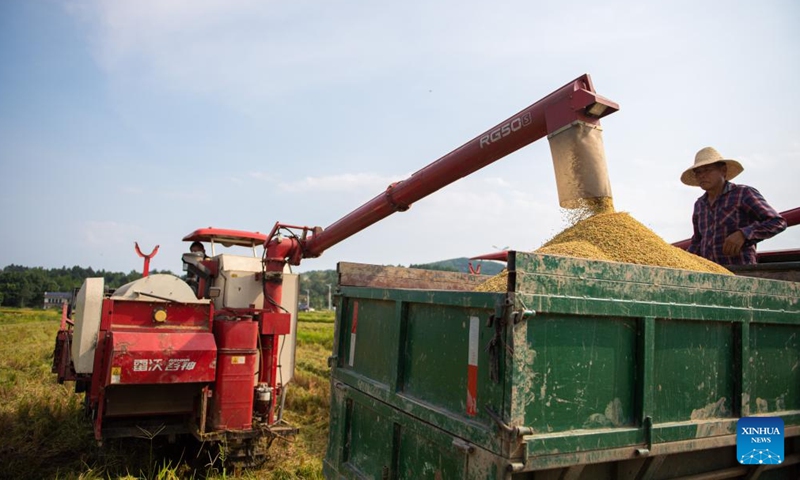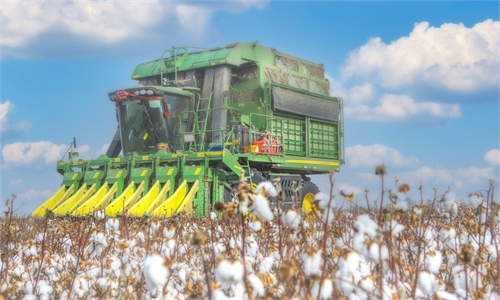Drought in southern China unlikely to have severe impact on grain production: experts

Farmers load the harvested rice in Xuefengshan Village of Taojiang County, central China's Hunan Province, July 16, 2022.Photo:Xinhua
Chinese crop planters are worrying about rice output amid an ongoing drought and continuous high temperatures in southern China, but market watchers think the impact on overall grain production won’t be too severe.
“Our profit for one mu is around 300 to 400 yuan, but the drought has eaten our profits, and we will even see a loss if the temperature stays high,” Zhang Wei, an owner of an area of 1,200 mu (800,000 square meters) of farmland in Danyang, East China’s Jiangsu Province told the Global Times on Friday.
He said that the temperature has been around 40 C for nearly one month and there has not been any rain.
Cao Hufu, who has nearly 3,000 mu of farmland in Loudi, Central China’s Hunan Province, told the Global Times on Friday that the region has suffered a drought for nearly one month, along with temperatures of over 40 C.
“The output for one mu of farmland will be cut by 20 percent at least, and 10 percent will not see any yield,” he said.
“I have witnessed several droughts in the past, but this is the first time I have seen high temperatures lasting so long,” he added.
Hunan is a major province for rice production in China. According to the local government, the province yields 4.5 percent of the country’s grain and it has 2.8 percent of the country's arable land.
Almost half of China is suffering another round of high temperatures. The National Meteorological Center (NMC) of the China Meteorological Administration (CMA) issued an orange high-temperature alert on Thursday morning, forecasting temperatures of 35 C to 39 C in 15 regions including Hunan Province and East China's Zhejiang and Fujian provinces.
The NMC said that the high temperatures will linger, including areas along the Yangtze River and Huaihe River, as well as in South China and the Sichuan Basin, with less rainfall than usual.
China's State Flood Control and Drought Relief Headquarters on Thursday activated a level-IV emergency response for droughts in some provincial-level regions. Drought conditions have occurred in Anhui, Jiangxi, Hubei, Hunan, Chongqing and Sichuan as southern China continues to experience high temperatures.
The Ministry of Water Resources said the water level of the main stream of the Yangtze River has hit a record low, and 9.67 million mu of arable land in 6 provinces and cities from Anhui to Sichuan have suffered from drought.
Jiangsu’s agricultural regulator on Thursday warned that the high temperatures pose a threat to the autumn grain yield, given that the autumn crops in Jiangsu are currently in a critical stage.
But experts said that while the hot weather might affect the rice yield in certain regions, it is unlikely to have too severe an impact on China's overall grain production.
The weather impact will be felt strongly in mountainous parts of the drainage areas of the Yangtze River where irrigation conditions are not so good, Li Guoxiang, a research fellow at the Rural Development Institute under the Chinese Academy of Social Sciences, told the Global Times on Friday.
According to Li, the extremely hot weather brings two risks for rice growth. First, it increases the risk of drought. Second, it also increases the risk from insects.
"However, since water supply is generally sufficient in southern China, I don't think the problem is very severe on a large scale," Li said, adding that he predicted China's rice output in 2022 should be similar to last year's level.
Jiao Shanwei, editor-in-chief of industry news website cngrain.com, said that hot weather will have some negative impact on rice cultivation by upsetting their seed setting rate, and it will be worse if there is a drought at the same time.
But Jiao stressed that the impact will be reduced by farmers using agricultural technologies, such as adjusting fertilizer application.
In a press conference on July 20, Liu Lihua, an official with the Ministry of Agriculture and Rural Affairs, predicted that China will see a bumper autumn harvest despite growing risks such as extreme weather and shifting planting conditions brought about by climate change.
Liu said the planting area for autumn grain has seen a steady expansion this year and the growth process for autumn grain crops is normal.
Affected by the high temperatures, the power supply and demand situation in East China’s Anhui Province has been uncertain recently, and many places have issued power curtailment notices.
As of Friday, all independent electric furnace equipment in Anhui Province has been suspended, according to iron and steel consultancy Mysteel.


